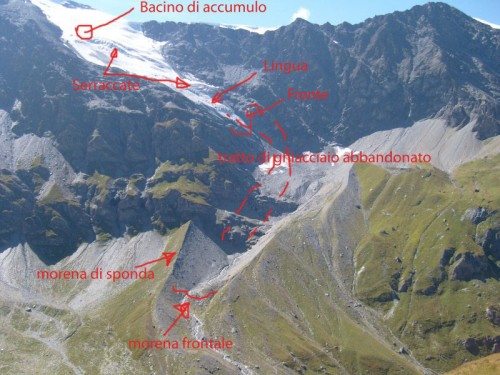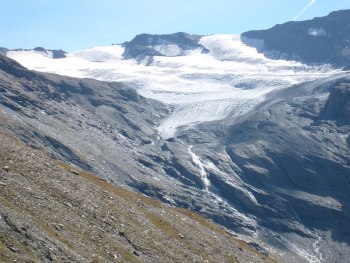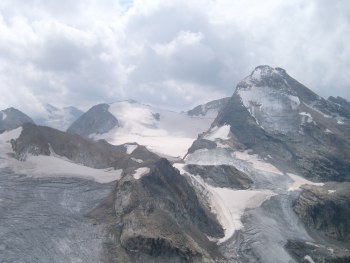Stefano Rossignoli 31 maggio 2009
Per definire un ghiacciaio, come diceva il mio professore di glaciologia all’università Il grande Claudio Smiraglia a cui io e i miei amici eravamo molto affezionati, bisogna cominciare con una parola:”Movimento”.
Un ghiacciaio è un’entità in movimento. E’ la forza di gravità che lo fa muovere, come se fosse un fiume al rallentatore.
Ma cos’è che si muove? Si muove del ghiaccio, che deriva dalla trasformazione della neve. In effetti, il ghiacciaio si forma per accumulo di neve in una zona di raccolta. La neve subisce una trasformazione e compattandosi si trasforma in ghiaccio. Quando la forza di gravità prende il sopravvento, questa massa di ghiaccio, ma anche di neve, detrito e tutto ciò che si trova sopra o all’interno, comincia a muoversi verso il basso fino a raggiungere la zona di ablazione, cioè quella dove avviene la FUSIONE o comunque la perdita di una parte del ghiaccio.
Abituati ad osservare i ghiacciai Alpini, immaginiamo sempre un bacino di accumulo che si trova ad alta quota dove le temperature sono più fredde ed una zona di ablazione a quote più basse, dove le temperature sono maggiori ed è favorita la fusione del ghiaccio.
Ben diverso è questo discorso per i ghiacciai polari, artici ed antartici, detti ghiacciai freddi…
Questi spesso arrivano fino al mare, in quanto la temperatura sul livello del mare è ancora favorevole all’accumulo e non alla fusione. In questo caso la massa di ghiaccio viene persa per ‘Calving’, cioè il distacco dei famosi Iceberg.
A questo proposito devo fare una piccola precisazione: non confondete il ghiaccio di ghiacciaio col ghiaccio marino che forma il pac che non è altro che acqua congelata e non certo neve trasformata…
Come già accennato, il ghiacciaio spesso si comporta come un fiume, quindi anch’esso trasporta del sedimento che si può trovare al di sopra, all’interno oppure alla base. Questo sedimento trasportato viene chiamato till. Una volta depositato, dà origine alle morene, ovvero ad accumuli di dimensioni quanto mai varie e a volte gigantesche di massi e ciotoli… E queste sono alcune evidenze che restano delle avanzate di antichi ghiacciai dell’era Quaternaria.
Tornando a paragonare il ghiacciaio ad un fiume, quando la pendenza aumenta, il fiume aumenta la sua velocità, si formano le rapide ed il flusso dell’acqua è notevolmente turbolento.
Anche il ghiacciaio si comporta di conseguenza ed aumenta la sua velocità. Invece delle rapide si aprono i crepacci e quando la velocità aumenta notevolmente, il ghiaccio si spezza ulteriormente e da origine alle seraccate, vere e proprie colate di blocchi di ghiaccio.
Esistono diverse classificazioni dei ghiacciai, basate sulla forma, altre sulla temperatura.
Diciamo innanzi tutto che nei ghiacciai delle calotte polari la temperatura del ghiaccio rimane sempre abbondantemente sotto gli 0°C. Questi vengono definiti ghiacciai freddi.
In essi la neve si trasforma in ghiaccio in moltissimo tempo e la base di appoggio è maggiormente ancorata al substrato su cui si muove il ghiacciaio.
Nei ghiacciai ‘di casa nostra’ detti temperati, la temperatura del ghiaccio è sempre intorno agli 0°C ed avviene fusione e rigelo delle acque, che percolano all’interno del ghiacciaio. Il manto nevoso si trasforma in ghiaccio molto più in fretta e la base del ghiacciaio scivola sul basamento.
In base alla forma, la classificazione è quanto mai varia e vi rimando alla letteratura specializzata, ma possiamo descrivere almeno un ghiacciaio ‘tipico’ alpino.

Questo presenta tipicamente una zona d’accumulo ad alta quota, da questa parte una lingua che termina in una fronte. Lateralmente alla lingua, possono formarsi morene di sponda e nella zona della fronte,la morena frontale.
Se le lingue di ghiacciai diversi si congiungono, tra loro si forma una morena mediana.
Mi rendo conto che l’argomento sia vastissimo quindi ci torneremo presto, soprattutto per comprendere come sono cambiati in passato e cosa dovremo aspettarci dal loro futuro.
La ‘Piccola Età Glaciale’
Andiamo a vedere un Ghiacciaio
Playlist video dal canale di youtube di scienzafacile

